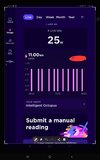I'll add that any hybrid inverter takes a short time to sync with load, typically a fraction of a second. The best way to see what's happening is the IHD of your smart meter. Likely over the course of the day, you'll have a fraction of a kWh from grid, and a fraction to grid for the time between the load change being detected and the inverter ramping/dropping the output to match.Yeah, if you're looking at the web dashboard for your inverter (or the mobile app), the data is only transmitted every few minutes so you get inconsistencies in what's shown at low loads. It annoyed me so I went down the Home Assistant route with my Fox setup.
Giv recently introduced a new firmware with supposedly faster response times, although I've not really seen much different to those totals




